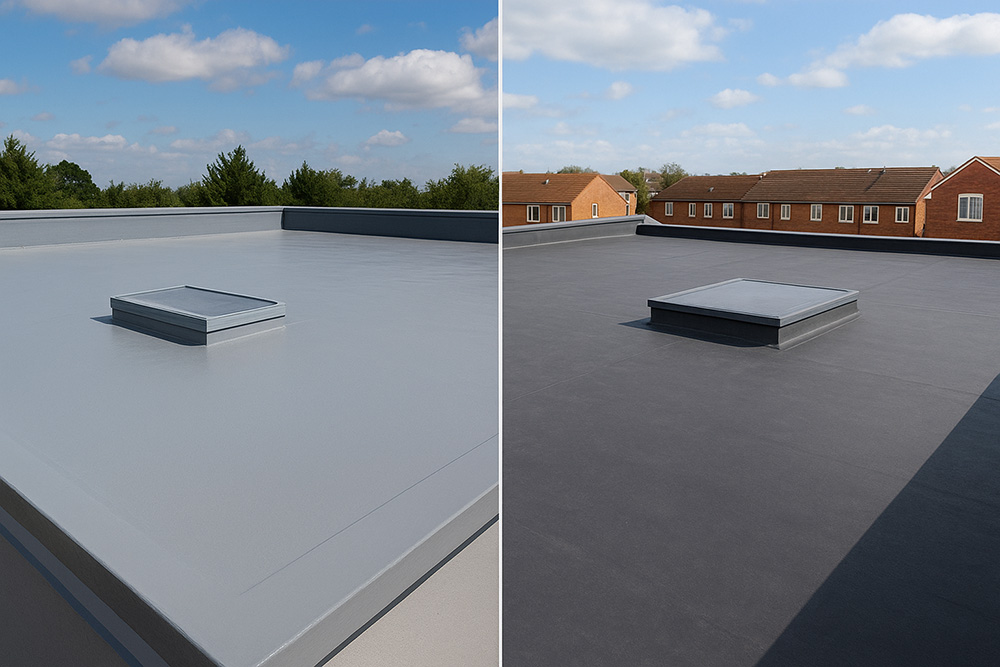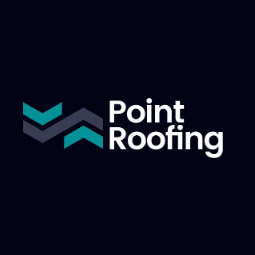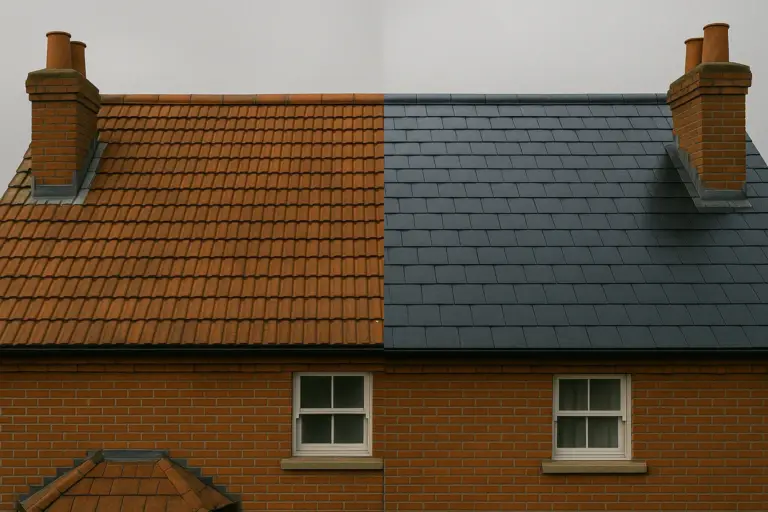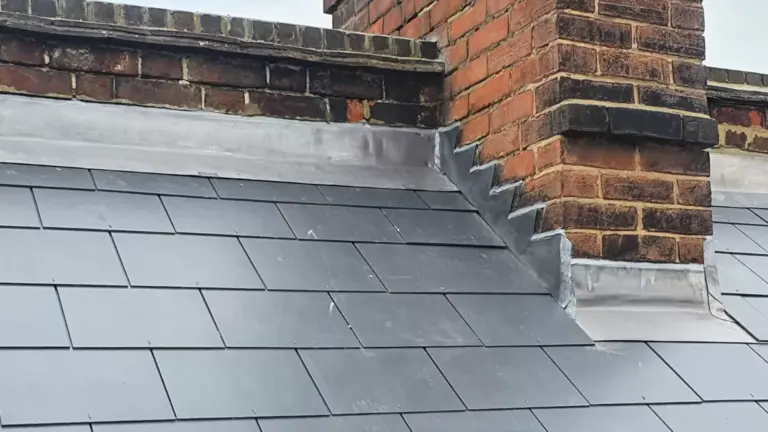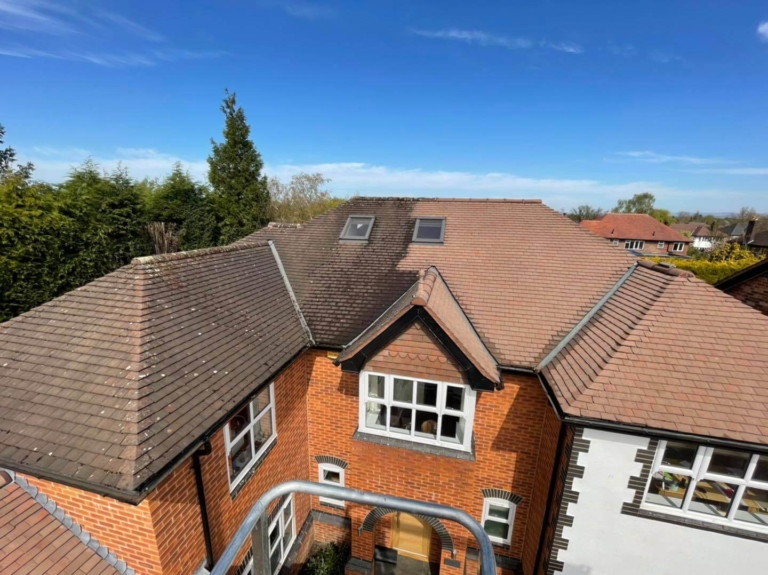Your flat roof is leaking. Again. That’s the third time this year.
The roofer who patched it last time told you it’s 15 years old and “living on borrowed time.” Now you need to replace it properly. But with what?
Flat roofing materials range from £40-150 per square metre installed. Lifespans vary from 10 years to 50+ years. Some materials you can install yourself. Others need specialist contractors with specific qualifications.
The “best” material depends entirely on your budget, how long you’re staying in the property, and what’s actually sitting underneath your current roof. That £150 per square metre premium material isn’t best if you’re selling in three years. The £40 budget option isn’t best if you’re planning to stay 20 years.
Here’s what you actually need to know about flat roofing materials.
Understanding “Flat” Roofs (They’re Not Actually Flat)
What makes a roof flat?
Flat roofs have a pitch of less than 10 degrees. But they’re never completely flat. A truly flat roof would create standing water, which destroys roofing materials rapidly.
Proper flat roofs have a minimum fall of 1:80. That’s 1cm drop per 80cm of roof. This subtle gradient allows water to drain towards outlets or edges.
Your existing flat roof probably has a fall built in. New materials need to maintain or improve this drainage. Water pooling on any flat roof material causes premature failure.
Felt Roofing: The Traditional Budget Choice
Felt has been the standard UK flat roof material for 60+ years. It’s cheap, readily available, and familiar to virtually every roofer.
Built-up felt roofing specifications:
Three-layer system using mineral felt Base layer, intermediate layer, cap sheet Hot bitumen bonds layers together Total thickness: 8-12mm Expected lifespan: 10-15 years
Costs:
Materials: £8-15 per square metre Installation: £40-60 per square metre Total installed cost: £50-75 per square metre
A typical 20 square metre flat roof costs £1,000-1,500 in felt.
Why Felt Still Exists Despite Better Alternatives
Felt roofing has serious limitations. Why does anyone still use it?
Price. It’s the cheapest flat roofing option by a significant margin. For landlords doing quick repairs on rental properties, or homeowners with limited budgets, felt works.
Every roofer knows how to install felt. You won’t struggle finding contractors. Availability is universal.
Felt can overlay existing felt roofs. If your current felt roof has only one or two layers, adding a third layer costs less than complete replacement.
The Problems with Felt
Felt roofing fails predictably. The felt itself becomes brittle over 10-15 years. UV radiation and temperature cycling degrade the bitumen. Cracks develop. Water penetrates.
Torch-on felt requires naked flames. Fire risk during installation is real. Insurance companies sometimes require notification before torch-on felt installation.
Felt roofs are difficult to repair invisibly. Patches are obvious and often don’t last long. When felt starts failing, you’re looking at full replacement within 2-3 years.
Temperature extremes affect felt badly. Hot summers make felt soft and vulnerable. Cold winters make it brittle and prone to cracking. The British weather’s constant temperature swings accelerate degradation.
When Felt Makes Sense
Budget is extremely tight and you need a roof that’ll last 10 years. You’re planning to sell within 5-8 years and need a functional roof without major investment. You’re a landlord managing multiple properties on tight margins.
Felt provides a functional roof for 10-15 years at the lowest possible cost. If that matches your needs, felt works.
EPDM Rubber: The Modern Standard
EPDM (Ethylene Propylene Diene Monomer) rubber roofing has become the UK’s most popular flat roof material for residential properties.
EPDM specifications:
Single-ply rubber membrane Thickness: 1.2mm-1.5mm typically Available in large sheets reducing seams Expected lifespan: 30-50 years UV resistant and extremely flexible
Costs:
Materials: £15-25 per square metre Installation: £65-90 per square metre Total installed cost: £80-115 per square metre
A 20 square metre EPDM roof costs £1,600-2,300.
Why EPDM Dominates Residential Flat Roofing
EPDM installation is relatively straightforward. Competent DIYers can install EPDM on simple rectangular roofs. This reduces costs significantly if you’re capable and confident.
The material is incredibly flexible. It accommodates building movement without cracking. Thermal expansion and contraction don’t damage EPDM like they damage felt.
EPDM is supplied in large sheets. A typical domestic flat roof might need just one sheet. Fewer seams mean fewer potential leak points.
Weather resistance is excellent. EPDM handles UV radiation, temperature extremes, and moisture brilliantly. It works in British weather conditions without degrading rapidly.
EPDM Installation Methods
Fully adhered EPDM uses adhesive across the entire roof deck. This creates the most secure, longest-lasting installation. Professional installation recommended.
Mechanically fastened EPDM uses plates and screws around edges with adhesive in the middle. Faster installation but slightly more vulnerable to wind uplift.
Ballasted EPDM uses the membrane’s weight plus additional ballast (gravel or pavers) to hold it down. Cheapest installation method but requires structural capacity for the ballast weight.
EPDM Limitations
EPDM is black and absorbs heat. In summer, EPDM roofs get significantly hotter than other materials. This matters for rooms directly beneath.
Seam welding requires skill. If your roof needs multiple sheets, the seams must be perfect. Poor seam installation is EPDM’s most common failure point.
Sharp objects can puncture EPDM. It’s tough but not indestructible. Debris, dropped tools, or storm-blown objects can damage the membrane.
GRP Fibreglass: The Premium Choice
GRP (Glass Reinforced Polyester) creates a seamless, rock-solid roof surface that lasts 30-40 years.
GRP specifications:
Fibreglass matting embedded in polyester resin Applied as liquid, cures to solid surface Completely seamless Thickness: 3-4mm Expected lifespan: 30-40 years
Costs:
Materials: £25-40 per square metre Installation: £90-120 per square metre Total installed cost: £115-160 per square metre
A 20 square metre GRP roof costs £2,300-3,200.
GRP’s Advantages
GRP creates completely seamless roofs. There are no joints, no seams, no potential leak points. It’s a single moulded surface.
The material is rigid when cured. You can walk on GRP roofs without worrying about damage. It’s the toughest flat roofing material for foot traffic.
GRP handles ponding water better than any alternative. Standing water doesn’t damage cured fibreglass. This makes GRP excellent for roofs with drainage problems.
Colour options exist. Standard GRP is grey, but coloured topcoats provide aesthetic variety. You’re not limited to black or grey.
Why GRP Isn’t More Popular
Installation requires specific skills and equipment. Not every roofer installs GRP. Finding qualified contractors is harder than finding EPDM or felt installers.
Application needs dry, mild weather. Installing GRP in rain or cold weather causes curing problems. This limits working windows during British winters.
The material is expensive. GRP costs 40-60% more than EPDM for similar performance. The seamless installation and durability justify this for some people, but many choose cheaper alternatives.
GRP degrades under prolonged UV exposure without topcoat. The grey surface can become chalky and brittle over 15-20 years if not protected with UV-resistant topcoat.
When GRP Makes Sense
You need absolute waterproofing reliability. You regularly access the roof (roof terrace, equipment maintenance). Your roof has complex shapes or penetrations. You’re planning to stay in the property 20+ years and want minimal maintenance. GRP is also easier to carry out flat roof repairs.
Single-Ply Membranes: TPO and PVC
TPO (Thermoplastic Polyolefin) and PVC single-ply membranes are common in commercial roofing and increasingly popular residentially.
TPO/PVC specifications:
Single-layer membrane Thickness: 1.2mm-2.0mm Heat-welded seams Expected lifespan: 25-35 years White surface reflects heat
Costs:
Materials: £18-30 per square metre Installation: £75-110 per square metre Total installed cost: £95-140 per square metre
Single-Ply Membrane Advantages
White surfaces reflect solar heat. TPO and PVC roofs stay significantly cooler than black EPDM or grey felt. This reduces cooling costs for rooms beneath.
Heat-welded seams create watertight joints. Properly welded TPO seams are as strong as the membrane itself. No adhesive degradation concerns.
Chemical resistance is excellent. TPO and PVC handle oil, grease, and various chemicals better than EPDM. This matters for roofs near kitchen exhausts or industrial settings.
Single-Ply Membrane Limitations
Installation requires expensive specialist equipment. Heat-welding needs proper machines that most general roofers don’t own.
Fewer contractors install these materials residentially. Finding qualified installers is challenging outside major cities.
Material costs more than EPDM for similar performance. You’re paying 15-25% more for heat reflection and chemical resistance you might not need.
Liquid Applied Membranes: The New Technology
Liquid waterproofing systems are applied as liquids and cure to seamless rubber membranes.
Liquid membrane specifications:
Polyurethane or acrylic base Applied with roller or spray Reinforcement fabric optional Thickness: 1-3mm Expected lifespan: 25-35 years
Costs:
Materials: £20-35 per square metre Installation: £70-100 per square metre Total installed cost: £90-135 per square metre
Liquid Membrane Benefits
Perfect for complex roof shapes. Liquid systems handle complicated details, penetrations, and irregular shapes better than sheet materials.
No seams or joins. Like GRP, liquid membranes cure to completely seamless surfaces.
Easy to repair. Damaged areas can be cleaned and recoated without replacing entire sections.
Excellent for refurbishment. Liquid systems can coat over existing materials, adding waterproofing without tear-off costs.
Liquid Membrane Drawbacks
Application requires skill and experience. Achieving correct thickness consistently needs expertise. Too thin creates weak spots. Too thick wastes expensive material.
Weather-dependent application. Most systems won’t cure properly below 5°C or in damp conditions. British weather limits working windows.
Quality varies enormously between products. Premium systems last 30+ years. Budget systems might fail in 10-15 years. Product selection is critical.
How to Choose Your Flat Roof Material
What actually matters for your specific situation?
Budget considerations:
Felt: £1,000-1,500 for 20m² (10-15 year lifespan = £67-150/year) EPDM: £1,600-2,300 for 20m² (30-50 year lifespan = £32-77/year) GRP: £2,300-3,200 for 20m² (30-40 year lifespan = £58-107/year)
Annual cost over expected lifespan makes EPDM the best value despite higher upfront costs. Point Roofing are able to carry out Felt, EPDM and GRP flat roof installations.
How long are you staying?
Selling within 5 years: Felt provides adequate value Staying 10-15 years: EPDM offers best balance Staying 20+ years: GRP or EPDM provide best long-term value
Roof access requirements:
No access needed: Any material works Occasional access: EPDM or GRP Regular foot traffic: GRP is most durable
Roof complexity:
Simple rectangular roof: EPDM is easiest installation Complex shapes or multiple penetrations: Liquid membrane or GRP Large roof area: Single-ply membranes with heat-welded seams
DIY vs professional installation:
Competent DIYer with simple roof: EPDM self-install possible Complex installation or limited DIY skills: Any material professionally installed Safety concerns with height or complexity: Always use professionals
Installation Quality Matters More Than Material Choice
The best flat roofing material installed badly fails quickly. Budget material installed perfectly lasts its full expected lifespan.
Critical installation factors:
Proper deck preparation. Any flat roof material needs a sound, dry, clean substrate. Installing over damaged decking guarantees failure.
Correct adhesive application. Most flat roof failures result from poor adhesion, not material failure. Adhesive coverage must be complete and even.
Perfect seam welding or bonding. Seams are always the weakest points. Professional seam work is essential.
Adequate edge detailing. Water enters most flat roofs at edges and penetrations, not through the main membrane. Edge details matter enormously.
Appropriate drainage. No flat roof material survives standing water indefinitely. Proper falls and drainage outlets are essential.
Maintenance Requirements by Material
Different materials need different maintenance approaches.
Felt roofing maintenance:
Annual inspection for cracks and blisters Solar reflective paint every 3-5 years extends life Patch repairs as needed Full replacement at 12-15 years typically
EPDM maintenance:
Annual inspection for debris and damage Clean with mild detergent and water Check seams and edges for lifting Minimal maintenance otherwise
GRP maintenance:
Annual cleaning UV topcoat reapplication every 10-15 years Inspect for cracks (rare but check anyway) Very low maintenance
Single-ply and liquid membranes:
Annual inspection Remove debris and vegetation Check penetration details Seam inspection for heat-welded systems
The Environmental Consideration
Which flat roofing material is most environmentally friendly?
EPDM is recyclable and many manufacturers use recycled content. Expected 40-50 year lifespan means infrequent replacement.
GRP isn’t recyclable but the long lifespan (30-40 years) reduces replacement frequency.
Felt has the shortest lifespan, requiring more frequent replacement. This creates more waste over 50 years. However, felt uses less energy to produce than synthetic materials.
TPO and PVC are partially recyclable. White surfaces reduce cooling energy, offsetting manufacturing impact.
Liquid membranes vary dramatically. Some systems are low-VOC and environmentally friendly. Others contain harsh chemicals.
Making Your Decision
There isn’t one “best” flat roof material. There’s the best material for your specific situation.
Tight budget and short-term ownership? Felt provides adequate value.
Long-term ownership and quality focus? EPDM offers best balance of cost, performance, and lifespan.
Premium durability and minimal maintenance? GRP delivers if budget allows.
Complex roof shapes or refurbishment projects? Liquid membranes handle complications well.
Large commercial or cooling-critical applications? Single-ply membranes offer specific advantages.
Get quotes for your specific roof from qualified contractors working with materials they regularly install. A felt specialist might quote EPDM but lack experience installing it properly. An EPDM specialist delivers better results with their preferred material than a generalist working outside their expertise.
The best flat roof material is the one that meets your budget, matches your timescale, suits your roof complexity, and gets installed properly by experienced contractors.
Choose based on your actual needs, not marketing claims or trendy materials. Your roof needs to work for your situation, not win architectural awards.
A properly installed felt roof outperforms a badly installed GRP roof every single time. Material quality matters, but installation quality matters more.
Get multiple quotes, check contractor experience with their proposed material, ask for references, and make your decision based on the complete package, material, installation quality, warranty, and price.
Your flat roof protects everything underneath. Choose wisely, but don’t overthink it. Any of these materials, properly installed and maintained, will serve you well for their expected lifespan.
If you need help choosing the right flat roof material or need a flat roof installed please get in touch with the Point Roofing team.


